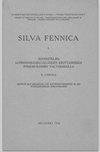热带地区不同地形生境的树洞密度和特征不同吗?以西双版纳为例
IF 1.7
3区 农林科学
Q2 FORESTRY
引用次数: 2
摘要
尽管洞穴对依赖洞穴的动物的生存和分布有影响,但热带森林不同生境类型的树洞密度和特征的变化尚不清楚。本研究在中国西南20公顷的热带雨林中调查了376个物种的26本文章由计算机程序翻译,如有差异,请以英文原文为准。
Do tree cavity density and characteristics vary across topographical habitats in the tropics? A case study from Xishuangbanna, southwest China
Despite the influence of cavities on the survival and distribution of cavity-dependent fauna, the variation in the density and characteristics of tree cavities across different habitat types in tropical forests is unknown. In this study, we surveyed 26â312 living trees from 376 species and compared cavity density and characteristics (height, size, type, and orientation) across five habitat types (valley, low-slope, high-slope, high-gully, and high-plateau) in a 20-hectare tropical rainforest in southwest China. From a total of 2047 cavities, we found that cavity density was mainly driven by habitat rather than tree species richness or diameter at breast height (DBH), and the characteristics of cavities were not uniformly distributed across habitats. Cavities were significantly more abundant in high- and low-slope than high-plateau habitats. Compared with other habitats, more âbutt hollowâ cavity types were found in high-slope habitat and they occurred at a lower tree height, whereas more âcrackâ cavities were found in low-slope habitat and they had a narrower entrance diameter. Although the mean orientation of cavities faced towards the northeast, cavity orientation varied significantly across habitat types. Our results indicate that certain types of cavities are concentrated in specific habitat types, which can provide avenues for forest management and biodiversity conservation. We highlight the importance of habitat heterogeneity in providing resources for cavity nesters.
求助全文
通过发布文献求助,成功后即可免费获取论文全文。
去求助
来源期刊

Silva Fennica
农林科学-林学
CiteScore
3.50
自引率
11.10%
发文量
21
审稿时长
3 months
期刊介绍:
Silva Fennica publishes significant new knowledge on forest sciences. The scope covers research on forestry and forest ecosystems. Silva Fennica aims to increase understanding on forest ecosystems, and sustainable use and conservation of forest resources. Use of forest resources includes all aspects of forestry containing biomass-based and non-timber products, economic and social factors etc.
 求助内容:
求助内容: 应助结果提醒方式:
应助结果提醒方式:


